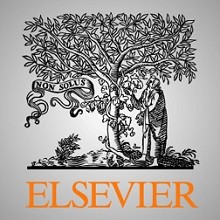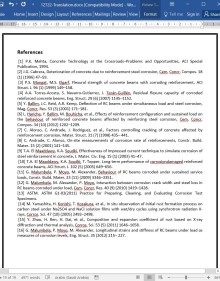
دانلود مقاله رفتار سازه ای تیرهای بتنی مسلح خورده شده تحت بارگذاری پایدار
چکیده
این مقاله نتایج یک مطالعه تجربی طراحی شده برای بررسی تاثیرات مرکب خوردگی و بارهای پایدار بر عملکرد سازه ای تیرهای بتنی مسلح را ارائه می کند. هشت تیر RC، شامل تیرهای خورده نشده و خورده شده تسریع یافته توسط روش حاضر، آزمایش شدند. تمام تیرها درمعرض یک بار خمشی پایدار چهارنقطه ای قرار گرفتند که به ترتیب معادل با 17، 33 یا 50درصد از بار نهایی طراحی شده بود. درجه خوردگی، الگوهای ترک، پهنای ترک و انحراف مرکز دهانه تیرها درطول آزمایش پایش شدند. نتایج نشان دادند که خوردگی آرماتور تاثیر مهمی بر فاصله بندی ترک عرضی نداشته و تاثیر اندکی بر گسترش پهنای ترک عرضی برای تیرها تحت بارگذاری و خوردگی و همزمان داشت. یک سطح بار بالاتر و یک چگالی جریان پایین تر منجر به اکسایش بیشتر محصولات خوردگی با یک نرخ انبساط حجمی بزرگتر شده که منجر به شروع زودرس و انتشار سریع ترک خوردگی و انحراف واضح تر تیرهای RC می شود. برای یک تیر تحت بارگذاری و خوردگی آرماتور همزمان، تاثیر خوردگی آرماتور بر انحراف آن نمی تواند نادیده گرفته شود، چونکه ممکن است از تاثیر خزش در یک درجه خوردگی نسبتا پایین فراتر رود.
1- مقدمه
بتن مسلح (RC) یکی از مواد ساختمانی بسیار استفاده شده در جهان است. سازه های RC معمولا بعنوان سازه های دائمی درنظر گرفته می شوند که می توانند عاری از مسائل زوال شدید برای یک دوره زمانی طولانی با توجه به عملکرد خدماتی خوب آن ها باشند. اگرچه میله های فولادی تعبیه شده در بتن معمولا درمقابل خوردگی درطول عمر خدماتی یک سازه محافظت می شوند، پوشش بتن می تواند تحت تاثیرات برخی عوامل مخرب خراب شده و منجر به خوردگی میله های فولادی در بتن شود. برای سازه های RC، خوردگی میله های فولادی یکی از مهمترین عواملی است که موجب مشکلات ماندگاری می شود ]1[. از یک سو، خوردگی می تواند منجر به اتلاف سطح مقطعی میله های فولادی و زوال خصوصیات مکانیکی آن ها و درنتیجه کاهش ظرفیت باربری یک عضو سازه شود. از سوی دیگر، خوردگی میله های فولادی همچنین می تواند رفتار پیوندی بین بتن و فولاد را خراب کرده و موجب کاهش سختی و درنتیجه افزایش انحراف در طول عمر خدمات شود.
تحقیقات بیشتری در مورد رفتار تیرهای RC خورده شده انجام شده است. اما، بیشتر کارهای قبلی بر رفتار کوتاه-مدت تیرهای RC خورده شده متمرکز بوده اند که در آن نمونه های تیر قبل گسیختگی بارگذاری خورده شده بودند. کابررا ]2[، منگات و همکاران ]3[ و تورس-آکوستا و همکاران ]4[ یافتند که پهنای ترک عرضی و فاصله-گذاری ترک با درجه خوردگی افزایش یافتند، ولی مقدار ترک ها کاهش یافت. درحقیقت، خوردگی میله های فولادی معمولا هنگامیکه یک سازه درمعرض یک بار پایدار قرار دارد اتفاق می افتد. بار پایدار ممکن است منجر به تسریع تاثیر بر فرآیند خوردگی شود ]5و6[. به علاوه، رفتار تیر تحت تاثیرات مرکب بارگذاری و خوردگی وابسته به زمان است. برای پیش بینی عمر خدمات سازه های RC خورده شده، تسریح رفتار وابسته به زمان تیر خورده شده مهم است.
5- نتیجه گیری
(1) ترک های عرضی تحت بارگذاری قبل از خوردگی آرماتور در آزمایش مشاهده شدند و خوردگی آرماتور تاثیر قابل توجهی بر فاصله بین ترک های عرضی نداشت و همچنین تاثیر اندکی بر عرض ترک داشت.
(2) منحنی های گسترش انحراف خصوصیات واضح تمام سه مرحله تحت بارگذاری و خوردگی آرماتور همزمان را نشان دادند. مرحله گسترش پایدار انحراف قبل از آغاز ترک خوردگی بوسیله مرحله گسترش سریع دنبال شد. مرحله پایدار دیگر انحراف هنگامی شروع شد که سطح مشترک بین فولاد و بتن و ترک های خوردگی بوسیله محصول خوردگی پر شدند.
(3) برای نمونه های تحت چگالی جریان یکسان، یک سطح بار پایین تر ممکن است آغاز و انتشار ترک خوردگی را به تاخیر بیندازد. به علاوه، برای نمونه های در معرض بارگذاری در سطح یکسان، یک چگالی جریان بالاتر ممکن است آغاز و انتشار ترک خوردگی را به تاخیر بیندازد. این آغاز و انتشار به تاخیر افتاده می تواند به اکسایش ناکافی بیشتر و یک انبساط حجمی پایین تر محصولات خوردگی نسبت داده شود.
(4) تاثیر خوردگی نمی تواند در محاسبه انحراف تیرها تحت بارگذاری و خوردگی آرماتور همزمان نادیده گرفته شود. در یک درجه خوردگی معین، تیرهای در معرض یک سطح بار بالاتر و یک چگالی جریان پایین تر یک انحراف بزرگتری خواهد داشت.
برای سازه های RC تحت یک محیط خورنده، مانند یک محیط آبی، تاثیرات خوردگی و بارهای پایدار دو عامل اصلی موثر بر عمر خدمات می باشند. نرخ های زوال اعضای سازه ای مختلف ناشی از نرخ خوردگی و سطح بار متفاوت خواهند بود. به منظور ارزیابی رفتار سازه ای سازه های RC تحت یک محیط خورنده، روشن کردن رابطه بین بار پایدار و نرخ خوردگی یک عضو سازه ای مهم می باشد. رفتار خمشی وابسته به زمان تیرهای RC در معرض سطح های بارگذاری مختلف و نرخ های خوردگی متفاوت در این مقاله می تواند برای بررسی عملکرد سازه های RC تحت خوردگی آرماتور و بارهای پایدار استفاده شود و همچنین می تواند به ارزیابی عمر خدمات سازه های RC تحت محیط خورنده کمک کند.
Abstract
This paper presents the results of an experimental study designed to investigate the combined effects of corrosion and sustained loads on the structural performance of reinforced concrete beams. A total of eight RC beams, including both uncorroded beams and corroded ones accelerated by the impressed current method, were tested. All the beams were subjected to a four-point sustained bending load which was equivalent to 17%, 33% or 50% of the designed ultimate load, respectively. Corrosion degree, crack patterns, crack width and mid-span deflection of the beams were monitored during the test. The results showed that reinforcement corrosion had no obvious effect on the transverse crack spacing and a slight effect on the development of transverse crack width for the beams under simultaneous loading and corrosion. A higher load level and a lower current density allow for more sufficient oxidation of corrosion products with a larger volume expansion rate, leading to premature initiation and rapid propagation of corrosion cracking, and more obvious deflection development of RC beams. For a beam under simultaneous loading and reinforcement corrosion, the effect of reinforcement corrosion on its deflection cannot be ignored, because it may exceed creep effect at a relatively low corrosion degree.
1. Introduction
Reinforced concrete (RC) is one of the most widely used construction materials in the world. RC structures are usually regarded as permanent structures that can be free of severe degradation problems for a long period time owing to their good service performance. Although steel bars embedded in concrete are normally protected against corrosion during the service life of a structure, the concrete cover can deteriorate under the effects of some aggressive agents, leading to corrosion of the steel bars in concrete. For RC structures, corrosion of steel bars is one of the most important factors causing durability problems [1]. On the one hand, corrosion can lead to the cross-sectional loss of steel bars and degradation of their mechanical properties thereby reducing the bearing capacity of a structural member. On the other hand, steel bars corrosion can also degrade the bonding behavior between the concrete and steel, thereby inducing stiffness reduction, which can increase the deflection during the service life.
Much research has been done on behavior of corroded RC beams. However, the most previous work has focused on the short-term behavior of corroded RC beams where the beam specimens were pre-corroded before loading to failure. Cabrera [2], Mangat et al. [3] and Torres-Acosta et al. [4] found that transverse crack width and crack spacing increased with the corrosion degree, but the quantity of cracks decreased. Actually, corrosion of steel bars normally takes place while a structure is subjected to a sustained load. The sustained load may lead to an accelerating effect on the corrosion process [5,6]. Furthermore, beam behavior under the combined effects of loading and corrosion is time-dependent. To predict the service life of corroded RC structures, it is important to clarify the time-dependent behavior of the corroded beam.
5. Conclusions
(1) Transverse cracks appeared under loading prior to reinforcement corrosion in the test, and the reinforcement corrosion had no obvious effect on the transverse crack spacing but a slight effect on the crack width.
(2) The deflection development curves displayed obvious characteristics of all three stages under simultaneous loading and reinforcement corrosion. The deflection stable development stage before the corrosion crack initiation was followed by the rapid development stage. The other stable stage of the deflection began when the interface between the steel and the concrete and corrosion cracks were filled up by the corrosion product.
(3) For the specimens under the same current density, a lower load level might delay the initiation and propagation of corrosion cracking. Furthermore, for the specimens subjected to loading at the same level, a higher current density might also delay the initiation and propagation of corrosion cracking. This delayed initiation and propagation can be attributed to more insufficient oxidation and a lower volume expansion of corrosion products.
(4) Corrosion effect cannot be ignored on the calculation of the deflection of the beams under simultaneous loading and reinforcement corrosion. At a certain corrosion degree, the beams subjected to a higher load level and a lower current density would have a larger deflection.
For RC structures under a corrosion environment, such as a marine environment, the effects of corrosion and sustained loads are two main factors influencing service life. Deterioration rates of different structural members will differ due to corrosion rate and the load level. In order to assess the structural behavior of RC structures under a corrosion environment, it’s important to clarify the relationship between the sustained load and the corrosion rate of a structural member. The time-dependent flexural behavior of RC beams subjected to different loading levels and different corrosion rates in this paper can be used to investigate the performance of RC structures under simultaneous reinforcement corrosion and sustained loads, and can also help assess the service life of RC structures under the corrosion environment.
چکیده
1- مقدمه
2- برنامه آزمایشی
2-1 آماده سازی نمونه
2-2 سیستم بارگذاری پایدار
2-3 خوردگی تسریع یافته در آرماتور
2-4 تکنیک ها و ابزارهای اندازه گیری
3- الگوهای ترک و عر ض های ترک
3-1 گسترش ترک تیرهای خورده نشده
3-2 تاثیر سطح بار بر گسترش ترک تیرهای خورده شده
3-3 تاثیر چگالی جریان اعمال شده بر گسترش ترک تیرهای خورده شده
4- گسترش انحراف تیرها
4-1 گسترش انحراف تیرهای خورده نشده
4-2 تاثیر سطح های بار بر گسترش انحراف تیرهای خورده شده
4-3 تاثیر چگالی جریان بر گسترش انحراف تیرهای خورده شده
4-4 تاثیر خزش بر گسترش انحراف تیرها
5- نتیجه گیری
منابع
Abstract
1. Introduction
2. Experimental program
2.1. Specimen preparation
2.2. Sustained loading system
2.3. Accelerated corrosion in reinforcement
2.4. Measuring techniques and instrumentation
3. Crack patterns and crack widths
3.1. Crack development of uncorroded beams
3.2. Effect of load level on the crack development of the corroded beams
3.3. Effect of applied current density on the crack development of the corroded beams
4. Deflection development of beams
4.1. Deflection development of uncorroded beams
4.2. Effect of load levels on deflection development of corroded beams
4.3. Effect of current density on deflection development of corroded beams
4.4. Creep effect on deflection development of beams
5. Conclusions
References
- اصل مقاله انگلیسی با فرمت ورد (word) با قابلیت ویرایش
- ترجمه فارسی مقاله با فرمت ورد (word) با قابلیت ویرایش، بدون آرم سایت ای ترجمه
- ترجمه فارسی مقاله با فرمت pdf، بدون آرم سایت ای ترجمه



